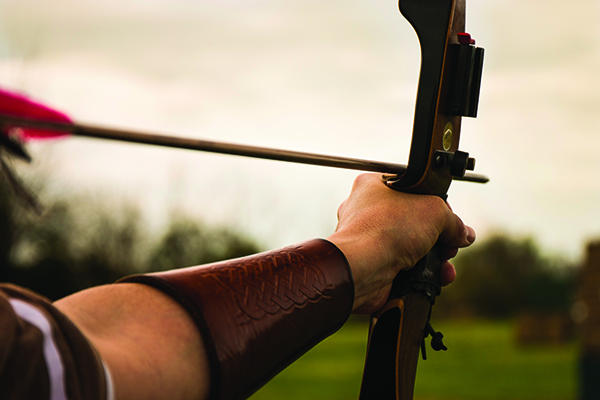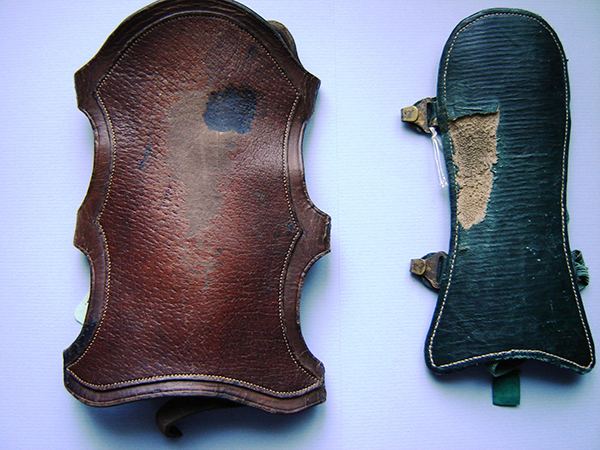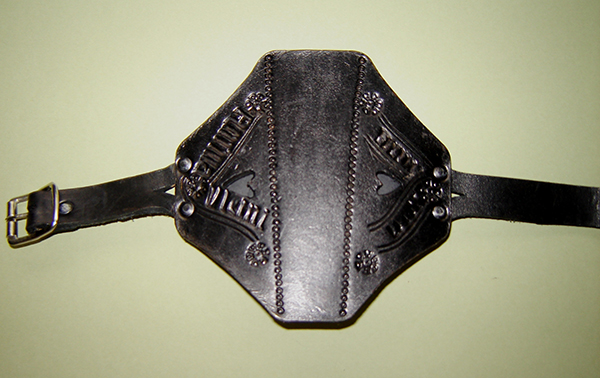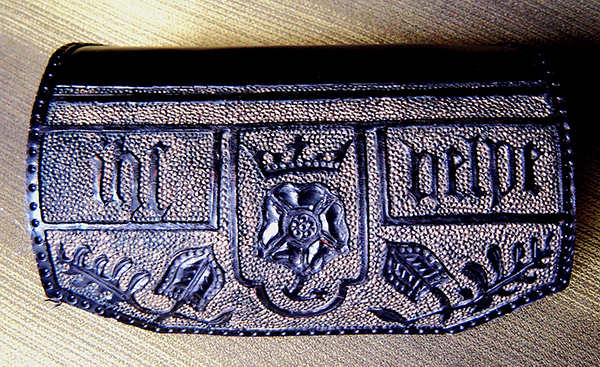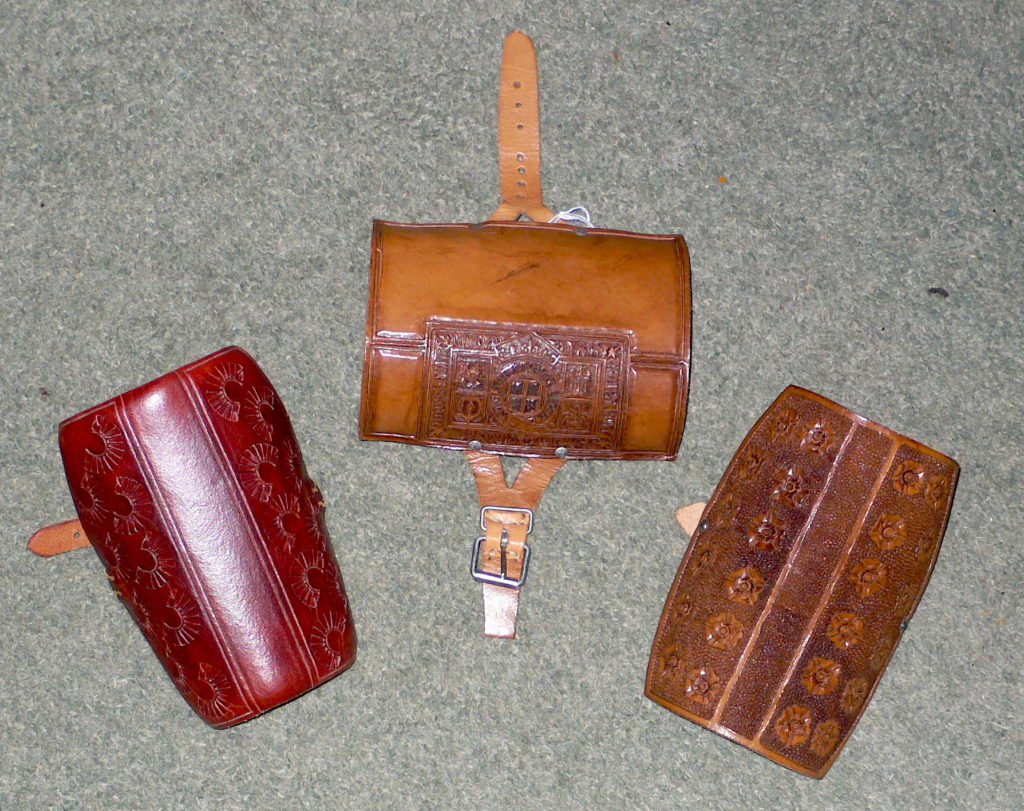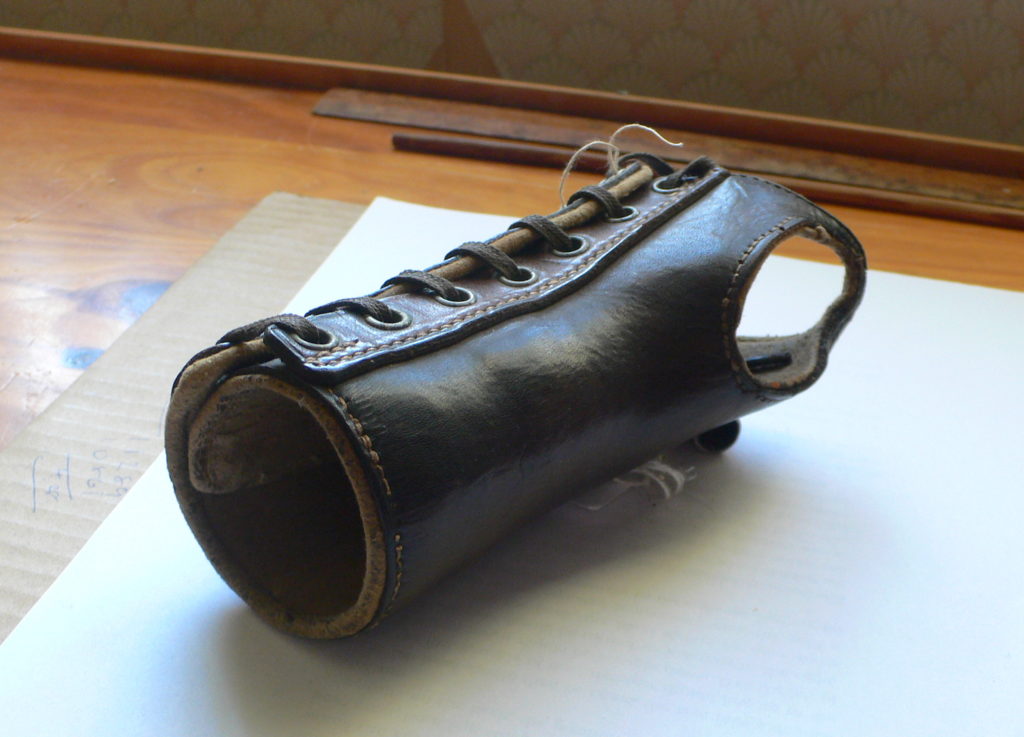Hugh Soar narrates a surprising history…
I wonder, when they unstrap their bracers, how many archers give more than a passing thought to this unobtrusive object, as it gets tossed carelessly into the bowcase?
Yet, it has a history comparable with that of the bow itself. For examples of the armguard, bracer, or wristguard – as archaeologists choose to call it – have been recovered from many a Neolithic grave. Two notable examples came when that of the ‘Amesbury archer’ was excavated; each of stone, one an undecorated basic workaday object, the other ornamented in gold, symbolic perhaps of authority. Each are on view within Salisbury Museum, together with the skeleton itself.
However, the scope and application of the bracer is wider than might be thought. Examples are worn by both cricketers and rugby players to protect the outer forearm, whilst a surprising use is found by care workers coping with those who are likely to be aggressive, to protect against bites and scratches.
There are a number of early drawings showing archers wearing arm-guards; however, historically we have gained much practical knowledge of 16th century bracers from those recovered from the wreck of the 16C Tudor warship, ‘Mary Rose’, each is described in detail within Part 2, Chapter 8 of the Archaeological Report, ‘Weapons of Warre’ – and offer a sample of those in common use.
Of the twenty-four bracers recovered, sixteen were decorated, and we will look at a few of the more interesting, but firstly we’ll briefly glance at an even earlier example recovered from the ‘Newport ship’, a fifteenth/sixteenth century trading vessel excavated at Newport in South Wales. Of backed black leather and hexagonal in shape, it is decorated with flower head symbols and two incised heart shapes beneath which is the partly obscured inscription, perhaps AMILLA, which is still providing a linguistic challenge for a handful of archery historians with nothing better to do.
Among the military material associated with the Fifteenth century Wars of the Roses are two armguards. One associated with the siege of Stogursey Castle in Somerset – at present in Taunton Museum – is a basic, dark pliable leather half sleeve, with lace holes for leather thong binding. A nondescript functional object, doubtless the discarded property of a ‘line’ bowman. The other, in the British Museum could not be more different and exhibits royal associations.
It too is a half sleeve, but in heavily decorated hard, tooled leather. It was found at Boulton Hall in Northumberland, and is said to have been left by King Henry VI himself, or one of the royal entourage, after his hurried departure following the Lancastrian defeat at the battle of Hexham. It features a multitude of leaves, – thought to represent the plantaginista flower, symbol of the Plantagenet dynasty, – within which a rose is centred bearing the initials I H S Helpe.. (Jesus Help)
Reverting to the ‘Mary Rose’ Collection, and their decorations, these fall into two categories, religious, and secular. Beside the obvious protective function, and the varied Christian symbols, at least two – and perhaps more – denote military affiliation. The two in question share Royal quarterings and Marian Aves covering one side of a rectangle.
They do pose an enigma however, since each appears to reflect an earlier Catholic era out of tune with the 1540’s. If they belonged to someone in authority, or indicated superiority, then their position – when recovered – may be significant. One: MR 81A1460 came from the main deck, the other from a chest in the hold.
Also from the main deck came MR 80A1973, decorated with eight crowned Tudor roses; and, the most enigmatic, MR.81A0815 an ivory bracer. This was recovered in position on a right arm, suggesting a left-handed archer. However, since sinistrals were regarded with suspicion bordering upon hostility it seems possible that this was worn not by an archer, but by someone of status and/or authority.
Ivory was the choice of aristocratic 17c French archers for their bracers; a selection of sixteen, decorated by engravings, each graphically illustrating the martyrdom of Saint Sebastien and donated by Victorian archer and national champion C.J, Longman, is housed within the Pitt-Rivers Museum, Oxford.
Returning to the Mary Rose; with two exceptions, – one of ivory, and one of horn – the bracers were of cow leather, varying between calf and mature. In passing, Gervase Markham, a 16c writer and archer remarks.: ‘bracers are made of the most part of Spanish leather, the smooth side outward and they be the best, and others are made of hard but smooth bend leather, and they are the worst and dangerous’.
All but two – which were laced – were fastened by a single strap and buckle (assumed, since none has survived), either ‘self’ or bifurcated. The laced examples are narrower, but significantly longer than the rest, and are perhaps representative of every-day, ‘run-of-the-mill’ arm protection. They are similar to an earlier laced sleeve bracer recovered during excavation at Stogursey Castle, Somerset.
The majority – as has been noted – were decorated. Some were adorned with simple, nondescript secular flower heads, others with fleur de lys or Tudor roses, the owners of which may also have had Royal military connections. Symbols appear to have been stamped, each neatly spaced and mostly in symmetrical order – a notable exception is that displaying various tools, where 32 mostly overlapping symbols are jumbled together.
A number were elaborately decorated, one with a collection of grid irons symbolic of the martyrdom of St.Lawrence and emblematic of the London Livery Company of Girdlers. (the livery companies were obliged to provide men for military service when required) another with St Peter’s Keys and Sword – symbols relevant to Exeter Cathedral; perhaps suggesting a West Country archer.
A third MR. 82A2282 was ornamented with tools of trade, thought either to show the instruments of the Passion, or the ‘Sunday Christ, a salutary warning against working on the Sabbath. Three were found in fragmentary condition, two decorated with flower symbols, a third associated with a ring bearing the image of a sheaf of arrows, suggestive of affiliation with the Fletchers Company.
Two particularly interesting examples MR 82A0943, and MR 81A4131 are derived from book covers. Each is decorated with four heads in profile enclosed within circles, striking in detail even after such lengthy immersion. The former is secured by a single bifurcated strap, the latter by two single straps. Speculatively the owners may have been connected with the Stationers livery company within whose orbit the Bookbinders fell.
Few bracers seem to have been directly associated with skeletons, suggesting that they were discarded in the panicked rush to leave the ship; however, unlike today, when the armguard is virtually a universal accoutrement, by no means all 15c archers wore one. Roger Ascham in ‘Toxophilus’, a contemporary account of archery then, explains:
‘Little is to be said of the bracer, .A bracer serves for several causes; one to save his arme from the strype of the stringe, and his doublet from wearing. And the other is, – that the stringe gliding sharplye and quicklye off the bracer may make the sharper (better) shoote. For if the stringe should light upon the bare sleeve , the strengthe of the shoote should stop. But it is beste by my judgmente to give the bowe so much bende that the string neede never touche the arme, and so shoulde a man need no bracer, as I knowe manye goode archers which occupy (use) none’.
Ascham had other advice: ‘In a bracer a man must take heed of 3 things, – that it have no nailes in it, nor buckles, that it be fastened without aigulettes. For these will sheere in sunder a man’s stringe before he be aware and put his bowe in jeopardy.’
Since a majority of the bracers recovered from the ‘Mary Rose’ wreck were fastened with strap and buckle, it would seem that this advice went unheeded.
Whether this function of the bracer to improve the shot was followed we have no way of knowing, however, nineteenth century bowyer Thomas Waring the Younger, in his 1827 booklet ‘A Treatise on Archery’ having exhorted the straightness of the bow arm, achieved by ‘turning the wrist in as much as possible’, adds helpfully ‘remember that the arm be so turned in that the string strikes it when loosed, but that will be treated of hereafter.’
This woolly disclaimer is vindicated by a reference later to the bracer ‘generally made of stout leather – the surface smooth that the string may better glide’.
In his book ‘Archery, its Theory and Practice’, published in 1856, national champion Horace Ford took both Ascham and Waring to task over their insistence upon the ‘straightened arm’, enhanced in Waring’s case by insistence on the ‘turned in’ wrist. With caustic wit he observes: ‘had he (Waring) directed the shooter to stand on is head whilst drawing, and to shut his eyes when aiming it had hardly been a more injurious doctrine’.
He then explained the correct position of the bow arm, accompanying it with an illustration. It is noteworthy that in the years following Ford’s book, the scores of competitive archers improved markedly.
Notwithstanding the contemporary advice, which may or not have been followed, the bracer of Mrs. Longman, wife of 1883 National Champion C.J. Longman (writer’s collection) certainly shows evidence of severe damage. Weak wrists were apparently endemic to Victorian lady archers however, particularly the younger ones, throwing the arm into the string’s path; to combat this an ingenious combination of armguard and wrist support was evolved.
And so, today, as traditionalists strap on their customised tooled leather bracers, and modern recurve and compound shooters pull on items of minimalist plastic, the lowly armguard is there, ready to function – secure in the knowledge that with five thousand years of history to its credit, it will never be outdated.


